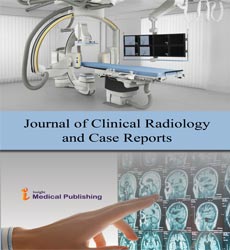Computed Tomography (CT) â?? Chest
Department of Drug Development, BioVectra Inc. Charlottetown, Canada, C1A. Email: pathakatul@gmail.com
- *Corresponding Author:
- Atul Pathak, Director, Department of Drug Development, BioVectra Inc. Charlottetown, Canada, C1A. Email: pathakatul@gmail.com
Received date: November 09, 2020; Accepted date: November 23, 2020; Published date: November 30, 2020
Copyright: © 2020 Atul P, et al. This is an open-access article distributed under the terms of the Creative Commons Attribution License, which permits unrestricted use, distribution, and reproduction in any medium, provided the original author and source are credited.
Computed tomography (CT) of the chest uses special x-ray equipment to seem at abnormalities found in other imaging tests and to help diagnose the reason for unexplained cough, shortness of breath, pain , fever and other chest symptoms. CT scanning is fast, painless, noninvasive and accurate. Because it's able to detect very small nodules within the lung, chest CT is especially effective for diagnosing carcinoma at its earliest, most curable stage.
Computed tomography, more commonly mentioned as a CT or scan , could also be a diagnostic medical imaging test. Like traditional x-rays, it produces multiple images or pictures of the within of the body.
The cross-sectional images generated during a CT scan are often reformatted in multiple planes. they will even generate three-dimensional images. These images are often viewed on a computer monitor, printed on film or by a 3D printer, or transferred to a CD or DVD.CT images of internal organs, bones, soft tissue and blood vessels provide greater detail than traditional x-rays, particularly of sentimental tissues and blood vessels.
Using a kind of techniques, including adjusting the radiation dose supported patient size and new software technology, the number of radiation needed to perform a chest CT scan are often significantly reduced. A low-dose chest CT produces images of sufficient quality to detect many lung diseases and abnormalities using much less radiation than a typical chest CT scan—in some cases lowering the dose by 65 percent or more. Low dose chest CT is routinely used for evaluation of acquired and congenital lung abnormalities, like pneumonia, interstitial lung disease or tumor evaluation. there's ongoing research to lower radiation doses even further. Your radiologist will decide the proper settings to be used for your scan relying on your medical problems and what information is required from the CT scan. If your child is to possess a CT scan, the proper low-dose pediatric settings should be used.
CT scanning has recently been approved for screening asymptomatic folks that have smoked an enormous amount of cigarettes by the Centers for Medicare and Medicaid Services.A CT angiogram (CTA) could even be performed to guage the blood vessels (arteries and veins) within the chest. This involves the rapid injection of an iodine-containing fluid (contrast material) into a vein while obtaining CT images.
In some ways , a CT scan works like other x-ray exams. Different body parts absorb x-rays in several amounts. This difference allows the doctor to differentiate body parts from one another on an x-ray or CT image.
In a conventional x-ray exam, alittle amount of radiation is directed through the a neighborhood of the body being examined. A special bitmap recording plate captures the image. Bones appear white on the x-ray. Soft tissue, just like the guts or liver, shows up in reminder gray. Air appears black.
With CT scanning, several x-ray beams and electronic x-ray detectors rotate around you. These measure the number of radiation being absorbed throughout your body. Sometimes, the exam table will move during the scan, so as that the x-ray beam follows a spiral path. A special bug processes this massive volume of data to form two-dimensional cross-sectional images of your body. These images are then displayed on a monitor. CT imaging is typically compared to looking into a loaf of bread by cutting the loaf into thin slices. When the image slices are reassembled by computer software, the result is a very detailed multidimensional view of the body's interior.
Refinements in detector technology allow nearly all CT scanners to urge multiple slices during one rotation. These scanners, called multi-slice or multidetector CT, allow thinner slices to be obtained during a shorter amount of some time . This results in more detail and additional view capabilities.
Modern CT scanners can scan through large sections of the body in just a few of seconds, and even faster in young children . Such speed is useful for all patients. It's especially beneficial for kids , the elderly and critically ill – anyone who finds it difficult to stay still, even for the brief time necessary to urge images.
For children, the CT scanner technique are getting to be adjusted to their size and thus the world of interest to reduce the radiation dose.
To produce high-quality scans at a lower radiation dose, low-dose CT scanning uses a selection of techniques, including:
dose modulation, during which radiation dosage is continuously adjusted to the patient's size at each location because the patient moves through the scanner. "noise management" software to filter unnecessary data. the utilization of shields (this method depends on the sort of CT scanner being used). external shields made out of bismuth could also be placed on the patient. the X-ray tube could also be turned off during a part of its rotation. lower peak voltage settings
A person who is extremely large won't fit into the opening of a typical CT scanner or could even be over the load limit—usually 450 pounds—for the moving table.
Open Access Journals
- Aquaculture & Veterinary Science
- Chemistry & Chemical Sciences
- Clinical Sciences
- Engineering
- General Science
- Genetics & Molecular Biology
- Health Care & Nursing
- Immunology & Microbiology
- Materials Science
- Mathematics & Physics
- Medical Sciences
- Neurology & Psychiatry
- Oncology & Cancer Science
- Pharmaceutical Sciences
